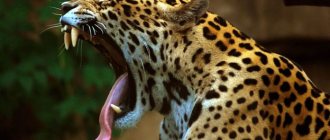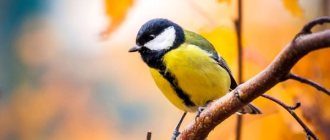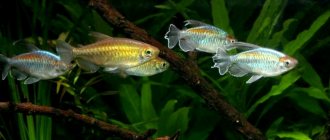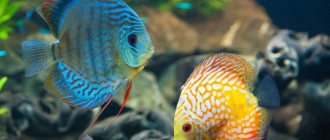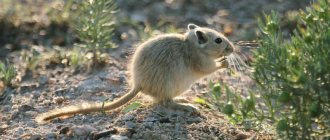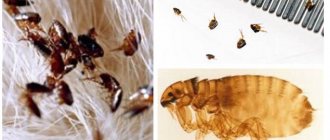Among all representatives of the bird community, the jay stands out for its rather large size and bright plumage; its active and shining blue plumage is characterized by the ability to sing and reproduce a whole set of original sounds.
Studying the photo of the jay, it is easy to imagine that, according to legend, its name comes from the ancient Russian concept meaning radiance, which is confirmed by its brilliant plumage, standing out in the dense crown of trees or bushes, where this feathered singer is most easily found.
General species characteristics
The dimensions of the most common species, the common jay, do not exceed 40 cm from beak to tail; the inconspicuous beige color of the plumage is surprisingly combined with eye-catching, bright blue and blue stripes on the wings, with black transverse inclusions.
A distinctive feature of this order is a noticeable crest on the head and a long, black and white tail; this color helps the jay to camouflage and avoid attacks from predators, while the weight of an adult does not exceed 200-250 grams.
Jay: Shining Mockingbird
The forest bird jay its whimsical name from the form of an ancient Russian verb, akin to the modern “shine,” for its bright feathers and lively disposition. Black-blue, blue and white spots, or mirrors, adorn the jay, the size of which does not exceed 40 cm with a tail.
The weight of an adult is about 200 grams. The body has an even beige color, and the wings are full of different colors. The legs are brown, the feathers on the chest are light. The appearance of a raised, attractive crest on the head signals the bird’s alarmed state. The blue jay is especially elegant among other species, thanks to the bright plumage on its back and the blue crest on its head.
The blue jay is distinguished by its plumage and the crest on its head
The jay is distinguished by a small, strong beak with sharp edges, adapted for splitting acorns, nuts and hard fruits. This shining bird can be found in a vast area of forests in Europe, North America and Asia.
Features of the jay's diet
In a forest or forest belt, the mockingjay bird performs the functions of a sentinel, announcing the area with loud and rather unpleasant sounds when people or predators approach, while it itself is a predator and is capable of eating the eggs and chicks of other birds.
The main diet of the feathered guard of its territory includes a variety of worms and all kinds of insects, small rodents and food of plant origin, such as oak acorns and nuts, seasonal berries and some plant seeds.
Note!
- Parrot: tips for choosing, the best breeds and rules for training different types of parrots (100 photos)
Eagle bird: description, species, lifestyle, habitat and interesting facts about the bird of prey (95 photos)
Parrot cage - features of choice
The breeding season of jays
In early spring, these birds begin searching for partners. Usually at this time jays try to move to live in dense forest thickets along the banks of rivers and lakes. Here they gather in flocks, begin to scream loudly and start battles. The process may take about a week. Next, the resulting couple immediately begins to search for a suitable place. The jay's nest is usually located on a very strong branch or in a branching area of trees.
The nest has the shape of a shallow bowl. Its outer contour is made of fairly rough branches, and the inner surface is lined with soft grass and leaves. After this, the female begins to lay eggs. There may be from 4 to 7 of them in a nest.
The eggs have a light green or yellowish-brown shell. Next, a pair of jays take turns incubating them. The incubation process, depending on weather conditions, can take from 15 to 17 days. Any jay chick is characterized by increased gluttony. Parents are forced to search for food all day long in order to feed their vocal offspring.
In years when there are not too many insects, some of the chicks die from hunger. With enough food, the young grow quickly and become stronger. Usually in this case, after 20 days they change their plumage to adult plumage and begin to fly out of the nest. However, the chicks become partially independent. They are under the care of their parents until the fall.
First, chicks should feed exclusively on caterpillars and beetles, since they require a lot of protein to form a skeleton and muscle frame. After feathering and the beginning of independent flights, they switch to plant food.
Existing species diversity
Ornithologists have identified and classified more than 40 species of jays, which are distinguished by special characteristics, strong physique, unique plumage and a signature, easily recognizable crest, and a good level of endurance.
A generalizing parameter can be attributed to a fairly bright and contrasting plumage, which is expressed in bright colors; this effect is created due to the refraction of natural sunlight, which is proven by various studies and studies of the structure of feathers, their color and tint range.
Description
The jay (Garrulus glandarius) is a large bird of the Corvidae family. It is the size of a well-fed pigeon. Length - up to 37 cm. The flight of the jay is heavy, with frequent flapping of its wings. A flying jay gives the impression of a larger bird than one sitting on a tree branch. If you see a jay flying at least once or look closely at it, you will always recognize this omnivorous representative of birds. The jay has a characteristic color: a reddish-gray head and back, black tail and wings. White rump. The fold of the wing (“mirror”) is decorated with bright blue feathers with black stripes and large white spots. In flight, the white spots on the wings and the snow-white rump are clearly visible. The light throat has black stripes on the sides. Young birds can be identified by their shorter tail and rufous plumage. The jay is a bird with light or blue-white eyes. In young birds they are brown.
The jay's head appears large and round. It has short, protruding black “antennae” and a tuft. The crest is not at all as wonderful as that of the waxwing. It looks more like ruffled feathers. The European jay has a light crest with black speckles, the Siberian jay has a buffy-red crest, and the Caucasian (Crimean) jay has a black crest.
Ornithologists have to describe not only the appearance and behavior of birds, but also their voice so that it can be recognized in the diverse chorus of birds. This is how the singing of jays is described in the bird guide: “The call is a rough, sharp cry “kzheek-kzhekk-kzhekk” and a nasal “keeeey-keeeey.” The song is quiet and very complex, consisting of a variety of creaking and gurgling sounds” (“Birds of Russia”, N. Arlott and V. Brave). The jay, like many corvids, has the ability to imitate the voices of other birds.
Jays are sometimes confused with jays (Perisoreus infaustus), another bird in the Corvidae family. The kuksha is smaller than the jay. It has a more uniform brownish-gray plumage and a dark brown crest on its head. This bird prefers coniferous forests. She is much more trusting than the timid jay. The flight of the kuksha is easy, while the bird opens its tail like a fan.
Conditions and habitat of jays
Knowing what a jay looks like, it is easy to distinguish it from other representatives of the feathered kingdom; the habitat of the bird of the corvid family is North and South America and certain parts of Eurasia; individual representatives of this species can be found in exotic Thailand and Malaysia.
Most often, birds are found in forests or woodlands; depending on the abundance of food supply, their habitat can expand to shrubs, but jays choose spreading and hollow trees of deciduous orders for breeding.
Types of jays
There are more than 40 species of these birds in the world. However, ornithologists say that there may be unstudied species living in places inaccessible to humans. The most common types are the following:
- The common jay lives in the forests of Europe, Asia and northern Africa. Among other species, it is considered the largest.
- Decorated jay - distinguished by a dark purple coloring of the head and wings, a brown tone of the back and abdomen. They are distributed only in Japan.
- Himalayan jay - lives in the Himalayas. The feather color is very diverse: the head is black and resembles a crow, the color of the body and wings is similar to the common jay, but the plumage on the back has a gray tint.
- Saxaul jay - lives in the bushes and steppes of Mongolia. In appearance it resembles a small crow. It is known that this bird prefers to run or jump, but it flies poorly.
- The crested jay has a long crest and gray-brown plumage. There is a black and white spot on the neck. Lives in Thailand and Malaysia. Unlike other species, it is not afraid of people. Young birds are distinguished by their striped, variegated color; as they grow older, the plumage changes to black.
- American blue jay - lives in mixed and pine forests of central America. The main color of its plumage is blue-blue, the belly and feathers around the eyes are white. The edges of the wings and tail are white.
- The black-headed jay is a bird that lives in Mexican forests. The structure of its tail is very similar to that of a magpie. The bird has a black crest that curls when excited. The plumage of the back, neck and tail is blue, the belly is white. The voice of these birds resembles the cry of parrots.
- Scrub Blue Jay - This species lives in the forested areas of Florida. The head, wings and back have blue plumage, the bottom is light gray. This species is rare and is listed in the Red Book.
- The Yucatan jay is a rare species; their representatives are very afraid of people, so it is difficult to see them. They live in the forests of North America in the ruins of old buildings. The head and body are covered with black plumage, the wings and tail are bright blue.
- The mockingjay is a species of bird created by crossing female mockingbirds and male chattering jays.
Unfortunately, the number of some species is significantly declining. This is due to thoughtless human activities, especially deforestation - the main habitat of these beautiful birds.
Red-listed blue jay in the wild
Bird nesting and breeding
Having studied the description of the jay, it is quite difficult to determine its sexual division, color and coloring are equally bright in representatives of both sexes of birds, which does not prevent them from creating strong married couples and maintaining devotion throughout their lives.
Birds choose trees for nesting, less often shrubs; the cup-shaped nest is made of various natural materials and insulated with down and feathers; often in such structures you can find small objects borrowed from people.
Appearance of a jay
These birds are rarely larger in size than the less colorful and memorable jackdaws. The length of the jay's body from beak to tail can reach approximately 40 cm. The jay's feather is small and smooth. The wingspan is quite large and is usually about 50 cm. A jay sitting on a branch looks smaller than when flying. The weight of the bird is relatively small and ranges from 170 to 200 g. The legs are long. Tenacious fingers crowned with small claws allow the bird to cling to branches more easily. The head is quite large. The beak of this bird species is short and pointed at the end. The upper beak is much larger than the lower one.
The decorated jay attracts attention with its bright plumage. Its back, chest, abdomen and upper part of the wings are covered with rusty-brown feathers. The crest on the head, as well as the tail and tips of the wings, are distinguished by their black color. In addition, the birds have bright blue feathers on their forearms. Black stripes run along them, which only creates additional contrast. In addition, there are large white spots on the wings. The rump of the bird is also light beige in color. There are black stripes on the throat running down the sides. Young birds have a shorter tail, and the plumage has a richer red color.
Photo of jay bird
Reproduction of blue jays
The breeding season of North American jays in the northern part of their range occurs once a year and occurs in May-June, and in the south jays breed twice.
Jays begin to form pairs with the beginning of the first sunny days, after which they build nests. They make nests in the forks of branches of coniferous or deciduous trees. The nests are located at a height of 3-10 meters above the ground. Both parents are engaged in construction. The outer part of the nest is made of twigs, and the inner part is lined with roots, wool, rags, clay and earth. The diameter of the nest can reach 20 centimeters, and its height reaches 10 centimeters.
The blue jay is only partly a migratory bird.
Before building the main nest, jays build several partial nests as part of ritual courtship. In addition, males, while courting females, feed their chosen ones. The female flies up to the male and assumes the pose of a chick, who asks for food, in response the male feeds her.
If a predator finds the nest, the blue jays may abandon it forever. Jays are loud, but become quiet during the breeding season. The clutch of a crested jay contains 2-7 eggs that are bluish or yellow-green in color with brown spots. The female does the incubation; the incubation period is 16-18 days.
The blue jay is a very beautiful bird with a long bright blue crest.
The chicks are blind and completely dependent on their parents. The female and male feed them, clean them, warm them and take care of their safety. The chicks' eyes open on the 5th day, and feathers appear on the 8th day.
When the chicks are about 12 days old, the female begins to fly out of the nest and look for food. A few days before departure, the chicks begin to crawl along neighboring branches, but do not move further than 4.5 meters from the nest. At 17-21 days they fly out of the nest. At first they circle not far from their parents' house. They stay close to their parents until autumn, but in winter they begin to live independently.
Sometimes jays imitate hawks to deceive other birds and drive them away from food.

